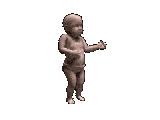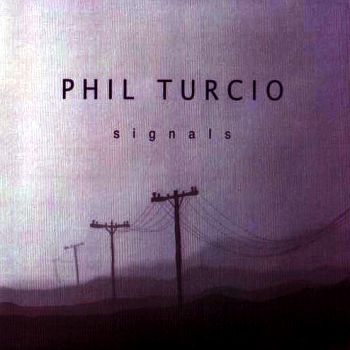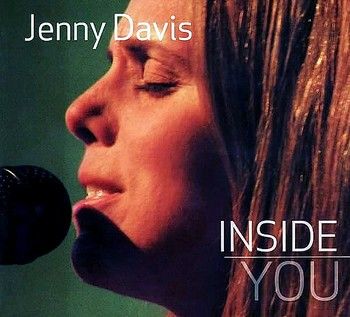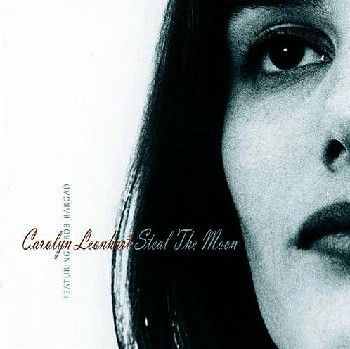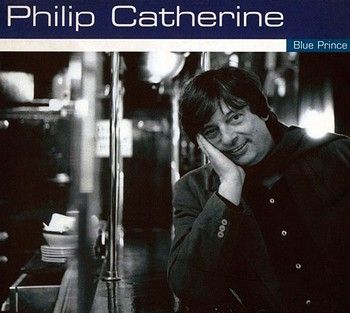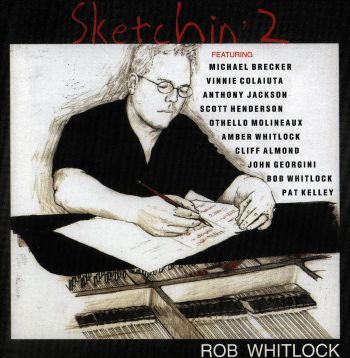
When reflecting upon the proverbial influence that the Hammond B3 electric organ has had on jazz, the first name that comes to mind is the incredible Jimmy Smith. Over time, cadres of very dominant organ specialists in their own right have followed a path layed by Mr. Smith. They include Wild Bill Davis, Richard "Groove" Holmes, Jack McDuff, Jimmy McGriff, Tony Monaco and a host of other notable individuals whose influence has impacted the overall jazz scene. In recent years, another noteworthy artist has been quietly making a name for himself as a creative force in jazz in the name of Rob Whitlock. In a very short span of time, Rob has established himself as a well respected musician while performing stints with Jaco Pastorius, Randy Berensen, Bill Watrous and Max Bennett. He has also toured extensively in the United States and Europe with A.J. Croce, the Dazz Band and Fattburger in numerous concerts and festivals. Further examination reveals that Rob’s overall grasp of music and jazz was overseen by his father, who comes to the table as a highly respected jazz guitarist. Having played the organ since the age of eight, Rob’s dad often encouraged him to do extemporaneous concerts in the family home for his musician friends. With that being said and other forces pushing Rob onward and upward into the musical universe, he has begun the process of expanding his perspective to a higher level of influence. To a much larger degree, Rob has been massaging his creative juices even more by spending some quality time in the recording studio. His latest album entitled Sketchin’ 2 is a stunning follow-up release to his Sketchin’ CD, which in my mind has revelations of a different sort, some of which are artistically different than what has been observed in previous Whitlock encounters. Sketchin’ 2 can best be described as a blues-based fusion jazz recording that contains cover songs as well as original arrangements. Included is a vocal interpretation of Billie Holiday’s "Them There Eyes," sung by Amber Whitlock. The sidemen include saxophonist Michael Brecker, trumpeter John Georgini, guitarists Pat Kelly, Bob Whitlock, Scott Henderson, bassist Anthony Jackson, percussionist Vinnie Colaiuta, drummer Cliff Almond and Othello Molineaux on steel pans. Collectively speaking, along with Rob Whitlock working his magic on keyboards, Sketchin 2 is an album that is well beyond the norm of most jazz heard today. On this release, Rob wrote as well as worked with others on four new songs to make this outing a happening. His eclectic and strategic use of fused nuances to highlight contemporary jazz and blues are the very essence of Whitlock’s appeal on this recording. Although he is the spearhead behind Sketchin’ 2, Rob takes the CD another further by allowing his stellar cast of sidemen to shine through at various times. As one reflects upon the theme of his original intent, Rob goes the distance in transposing his ideas into thought-provoking musical relevance. The intuitive creative spirit that comes from within is alive and kicking on such tracks as "2nd Service," "Cold Duck Time" and "Gotta’ Insulator." In retrospect, this CD has Whitlock and company jamming through a complex set of grooves that are hard-driving forays into the very crust of fusion-based jazz. Sketchin’ 2 has a variety of multi-faceted dynamics to make it a compelling piece of work. One tidbit of déjà vu has Julius Pastorius, son of the late bassist Jaco Pastorius, doing the album’s artwork. That mosaic along with the fusion-based rhythms of Rob Whitlock and his band of studio musicians provide a panoramic view of everything cool about jazz as a work of artistic importance. Based upon my first and last impression of Sketchin’ 2 and my introduction to Rob Whitlock, I am compelled to get excited about what could be forthcoming from a Hammond B3 organ master craftsman. [Rating:Four Stars] Written by & © Sheldon T. Nunn 20.02.2006 © 2013 - 2014 jazzreview.com. All rights reserved. http://www.jazzreview.com/cd-reviews/fusion-cd-reviews/sketchin-2-by-rob-whitlock.html
The veteran keyboardist fully embodies the art of independent jazz-making on this engaging and wildly eclectic project, which involved a series of exciting recording sessions that took place over a two-year span with a high-pedigree supporting cast. This includes Michael Brecker (whose feisty tenor adds punch and fire to the downtempo bluesy moods of "2nd Service"), Vinnie Colauita, Anthony Jackson (contrabass guitar), Scott Henderson (whose electric guitar does a slow, blistering burn through "Gotta Insulator"), Othello Molineaux (whose tropical touch on steel pans drives "2nd Service" before Brecker takes over), Cliff Almond (drums), and Pat Kelley (electric guitar on the romantic, late-night smoky ballad "Do I Love You"). As a follow-up to 2005's Sketchin', the new collection has a bit of an edgier and "retro" feel to it, but the results are always engaging and provoke a wide range of emotions. The mix also offers some cool surprises. Just as you're being seduced by the Spyro Gyra-like flavors of the opening track, Amber Whitlock's graceful vocals on the gently swinging jazz standard "Them There Eyes" puts you in a whole other traditional place. You're riding the funky highway of "Gotta Insulator," and the always wild and bluesy fun of Eddie Harris' "Cold Duck Time" comes along and spins you in a whole other rhythmic direction (with Henderson leading the way into a fusion neverland, of course). Following that, "At Freedom Chicken Dance" is the ultimate crazy-maker highlighted by more shenanigans from Henderson and scorching horn accents. The much gentler closer, "The Colours of Life," was the soothing radio track, but it seems like a slight letdown, being so simple and straightforward after all of the exciting oddities and fun that came before it. - Review by & © Jonathan Widran © 2014 AllMusic, a division of All Media Network, LLC. | All Rights Reserved http://www.allmusic.com/album/sketchin-vol-2-mw0001442610
FOR IMMEDIATE RELEASE May 1, 2006: Keyboardist Rob Whitlock takes his place on center stage backed by a stellar supporting cast on Sketchin’ 2 Duet with Michael Brecker at radio while the critics praise the new collection of jazz, blues and fusion. After more than two decades of recording, performing and touring in support of jazz, pop and R&B stars, keyboardist-producer-composer-arranger Rob Whitlock is ready for his close-up. This time, the luminous cast is supporting him on Sketchin’ 2, the album that hit the streets this week on the artist’s own Sketchin’ Records label. A “musician’s musician,” Whitlock is a sought after Hammond B3 organist, who also plays piano and keyboards. He was joined in recording studios throughout the U.S. over a two-year span to work on the eclectic Sketchin’ project. Along with Michael Brecker, Vinnie Colaiuta, Anthony Jackson, Scott Henderson, Othello Molineaux, Pat Kelley, and Cliff Almond, Whitlock recorded enough musical sketches that incorporate a variety of genres to populate two albums. The first disc was released last fall. Last month, smooth jazz radio stations were given an advance taste of the second collection with “The Colours Of Life” (instrumental reprise), a simple, heartfelt piano and sax duet between Whitlock and Brecker. Whitlock composed or collaborated on four new songs while producing and arranging Sketchin’ 2. He challenges listeners by presenting compositions culled from traditional and contemporary jazz, blues, and fusion. Sometimes his keyboard artistry leads and other times he takes a back seat to allow a sax, a guitar or a vocalist to pilot the track. The production is warm and organic because being able to play these songs live is important to Whitlock. To that end, he will bring a band comprised of Jackson (bass), Almond (drums), Mike Miller (guitar), and Amber Whitlock(vocals) to perform music from the Sketchin’ series to San Diego (May 27th at Dizzy’s), San Juan Capistrano (May 28th at KSBR-FM’s Birthday Bash) and Los Angeles (June 2nd at the Baked Potato), with additional dates and cities soon to be announced. Although the album just hit the streets, it was greeted with positive buzz. All Music Guide wrote, “The veteran keyboardist fully embodies the art of independent jazz-making on this engaging and wildly eclectic project…As a follow-up to 2005's Sketchin', the new collection has a bit of an edgier and ‘retro’ feel to it, but the results are always engaging and provoke a wide range of emotions. The mix also offers some cool surprises.” EJazzNews.com stated, “Whitlock directs his band-mates through an affable course of action, where jazzy funk grooves, soaring horns and a synthesis of cross-genre components coalesce for an enticing set of musical notions. The keyboardist’s sweeping B-3 lines generate a peppery edge within Brazilian-tinged jazz- grooves, and R&B drenched motifs…Whitlock’s muse is immersed within a multihued musical palate. He injects hard-driving mosaics spanning divergent rhythmic forays, complementing his substantial writing/arranging faculties amid the musicians’ obvious sense of conviction.” All About Jazz added, “Filled with a catchy mixture of rock, funk and jazz beats, Sketchin' 2, with first-rate musicians easily weaves between the lines of what used to be called 70's rock & fusion…‘The Colours of Life’ (is) a haunting mixture of Rob Whitlock's animated keyboards and Brecker's amazing tenor…If you’ve been missing the work of Donald Fagen and Walter Becker (Steely Dan), Sketchin’ 2 is a worthy alternative that demands attention.” SmoothJazz.com concluded, “There is some serious jazz on this disc...make no mistake about it...seriously great jazz…We can't overlook the stunning vocal performance from Rob's wife, Amber, on the Billie Holiday staple, ‘Them There Eyes’…Overall, Sketchin’ 2 from Rob Whitlock is first-rate material performed by first-rate musicians, and the results are awesome!” Julius Pastorius, son of the late bass legend Jaco Pastorius, did the album artwork for Sketchin’ 2, which is comprised of a series of intricate sketches of the musicians captured in the record- ing studio. The concept was for the illustrations to tell a story of the music and the musicians involved as album artwork often did in the days before music videos. However, to please the video inclined, the album is an enhanced CD that contains still photos and sketches from the recording sessions set to music in a video format. Additional information on Whitlock can be found at www.robwhitlock.com © robwhitlock.com
AAJ said that “Sketchin' 2” is “Filled with a catchy mixture of rock, funk and jazz beats....Sketchin' 2, with first-rate musicians easily weaves between the lines of what used to be called 70's rock & fusion”. SmoothJazz.com said, “There is some serious jazz on this disc...make no mistake about it...seriously great jazz....We can't overlook the stunning vocal performance from Rob's wife, Amber, on the Billie Holiday staple, ‘Them There Eyes’....Overall, Sketchin’ 2 from Rob Whitlock is first-rate material performed by first-rate musicians, and the results are awesome!” “Sketchin’ 2” is a really cool jazz album from the great West Virginian composer and keyboardist Rob Whitlock. Rob is helped out by artists that include Scott Henderson, Anthony Jackson, Vinnie Colaiuta, Michael Brecker, and his wife Amber Whitlock who sings lead vocals on “Them There Eyes”. This is great music with funk, soul, rock, jazz, R&B, fusion, Latin and many other elements. When you need a break from shredding and prog. rock, give this album a listen. Quality jazz with fabulous musicianship, and HR by A.O.O.F.C. Check out Rob’s “Sketchin'” album [All tracks @ 320 Kbps: File size = 105 Mb]
TRACKS / COMPOSERS
1 2nd Service - Rob Whitlock 6:59
2 Them There Eyes - Maceo Pinkard / Doris Tauber / Amber Whitlock / Rob Whitlock 4:44
3 Gotta Insulator - Rob Whitlock 7:53
4 Cold Duck Time - Eddie Harris 5:18
5 At Freedom Chicken Dance - Pee Wee Ellis / Eddie Harris / Rob Whitlock 6:54
6 Do I Love You - Richard Rogers 4:43
7 The Colours of Life (Reprise) - Amber Whitlock / Rob Whitlock 9:25
MUSICIANS
Pat Kelley, Scott Henderson - Guitar
Anthony Jackson - Contrabass Guitar
Rob Whitlock - Hammond Organ, Piano, Loop, Horn Arrangements
Vinnie Colaiuta, Cliff Almond - Drums
Othello Molineaux - Steel Pan
Michael Brecker - Tenor Sax, EWI, Saxophone Arrangement
John Rekevics - Saxophone, Bass Clarinet, Horn Arrangements, Orchestration
Wayne Bergeron - Trumpet
Andy Martin - Trombone
John Georgini - Flugelhorn, Muted Trumpet
Amber Whitlock - Lead Vocals on Track 2
BIO
Rob Whitlock, a naturally gifted musician, finds himself equally comfortable writing, arranging and producing music, soloing spontaneously or comping supportively behind other soloists, making them sound even better themselves. It's easy to see that Rob enjoys playing and even more enjoys whom he's playing with. Musicians with this balance of style and grace are not as easy to find as one might think. Finding expression through an artist with this combination of gifts is what truley makes music a language in it's own right, and Whitlock speaks it fluently. Rob has been playing the Hammond B-3 organ since age eight, when his father, a well respected jazz guitarist in Miami/Ft. Lauderdale encouraged him to do impromptu concerts in their family living room for professional musician friends. He was greatly influenced by Jimmy Smith, Wes Mongomery and Charlie Parker recordings from his dad's collection of jazz. On his own he discoverd Herbie Hancock, George Duke, Chick Corea, Miles Davis and Jaco Pastorius. The young musician quickly learned how to make a living by gigging around the area on keyboards as well as bass. At the age of seventeen, Rob met Jaco, who gave advice and encouragement to his younger friend. Jaco also sent friends to Rob's father for guitar lessons, having learned quite a bit himself from the senior Whitlock. After having played with great musicians like Jaco Pastorius, Randy Berensen, Othello Molineaux, Carl Fontana, Joe Williams, Bill Watrous and "The Peter Graves Big Band", as well as a host of unknown, but extremely talented New York transplants, Rob relocated to California at age 25, via a three year stint in Washington, D.C. In California, Whitlock became involved with some gifted musicians and formed a band with them playing contemporary jazz by groups like "The Brecker Brothers", "Yellow Jackets" and performed songs by writers Victor Feldman, John Scofield and Don Grolnick, as well as their own originals. During that time Max Bennett of "Tom Scott and the LA Express", asked Rob to join his originals band, of which Whitlock is currently still a member. Not long after, he began touring with "The Jazz Crusaders" through the U.S. and Europe on keyboards. With AJ Croce, while playing the B-3, he toured Scandanavia, as well as many other destinations with the Dazz Band and Fattburger, for festivals and concerts. As far as recording goes, Rob has been on anywhere from Kathie Lee Gifford and Rita Coolidge, to Fattburger, Steve Laury, Pat Kelley, Wayne Johnson and Max Bennett albums, ranging from pop to the many jazz genres. He has also been on recordings with legendary musicians like Vinnie Colaiuta, John Guerin, Joe Sample, Russell Ferante, Tom Scott, Warren Wiebie, Anthony Jackson and including greats Jeff Lorber, Will Lee, Bill Berg, Jimmy Johnson, Jim Gilstrap, Mike Miller, Scott Henderson, Greg Bissonette, Matt Bissonette, Cliff Almond, John Ferraro, Earnest Tibbs , Othello Molineaux, Bob Magnuson and Peter Sprague. Concert and club appearances include; Eddie Harris, Charles McPhearson, Abe Laboriel, Jaco Pastorius, Felix Pastorius, Tom Scott, Joe Williams, Ronnie Laws, Joe Sample, Lee Greenwood, Mavis Staples, Miki Howard, The Dazz Band, Mundell Lowe, Bobby Shew, Wayne Johnson, Peter Sprague, Sam Riney, Grant Geissman, Jeff Kashiwa, Bud Shank and Fattburger. Television appearances include "Austin City Limits"," Sound FX" on Fox, "The Wayne Brady Show", Katie Lee Gifford's most recent TV concert, "Gentle Grace", and others. Rob has written for television for the lifetime and other cable channels, and continues to do so. After having completed two new cds for himself ( "Sketchin" and "Sketcthin' 2" ), as well as two for his wife, vocalist Amber Whitlock ("The Colours of Life" and "The Circle" ), Rob is making plans to perform the new works in venues in the states and abroad. The musicians of choice for these projects were the incomparable Vinnie Colaiuta, Anthony Jackson, Scott Henderson, Cliff Almond, Pat Kelley and the amazing Michael Brecker. Also featured are old friends, Othello Molineaux, Wayne Johnson, Brian Price, his former college instructor, John Georgini, as well as Rob's father, Bob Whitlock on guitar and pedal steel. The horn section was comprised of three of Rob's favorites, Wayne Bergeron, Andy Martin & great buddy John Rekevics. Rob's new solo cd "Sketchin" incudes only a few of the talented artists he has come to know over the years, and includes original songs that he has written over the span of two decades. It has been above all, a labor of love; Love of music, of fellow musicians and their gifts, and of the enthusiast for whom he is happy to present this work, the jewel of his labor. In the words of eleven time Grammy Award winner Michael Brecker, "It was a joy to be a part of the Rob Whitlock project. In addition to his being a fantastic player/composer, Rob has a knack for bringing out the best in the musicians with whom he plays. This was fun." © 2005 Rob Whitlock. All rights reserved. http://www.robwhitlock.com/longbio.html
